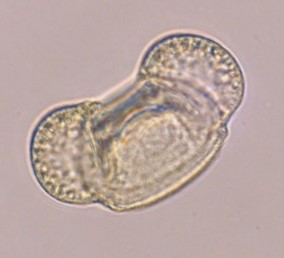Hello future BIO299 student!
My name is Julie Helene Eriksen and I have just spent most of my time this semester analysing pollen grains for this course. This might sound like a tiresome task, but in reality, it has given me great joy. Conducting experiments can be very time consuming, but it a very important aspect of science that might lead to groundbreaking observations. The reason I have been studying and observing an incredibly large amount of pollen grains is to determine how UV-B radiation affect the malformation rate by exposing pollen to different treatments. By malformations I simply refer to a pollen grain looking abnormal. If the pollen from Pinus sylvestris (Scots pine) that I have been observing lacks or has additional structures to it, or simply looks underdeveloped or unidentifiable, then I have registered this by taking pictures and noting it into a datasheet. The data I have collected by spending hours looking through the microscope has given some very interesting results!
I will not go too much in detail on any of the technical stuff, but it might be nice to have some general information about the project:
- Branches from P. sylvestris has been collected from a mountain in Norway.
- The branches were separated into two groups that was exposed to different UV-B treatments.
- One group was irradiated with an increased amount of UV-B, whilst the other received no UV-B irradiation.
Fig 1: Normal pollen grain of P. sylvestris
Fig 2: Some of the malformed P. sylvestris pollen I observed
I have found some very interesting malformations, and the rate of the malformation occurrence simply by observing and counting pollen grains through a microscope. I know what you’re thinking, but yes, it can be that simple conducting science!
What this data can be used for, which is the exciting part, is to create a proxy that can estimate what level of UV-B radiation that irradiated earths surface hundreds of millions of years ago. By doing this we can determine whether UV-B radiation had a big impact on some of the big extinction events throughout history! This is an incredible exciting aspect of science, and it is my drive for going through each slide with pollen grains and counting them to the thousands. As a BIO299 student that has found some really interesting results in my research, I would greatly recommend to any curious biology student to take part in your own experiment in order to conduct your own research. It is truly the best feeling when the results start to show.
(Oh and since I’ve mentioned several times in this post that I’ve been looking at many pollen grains, so far my observed pollen count is: 18 033, and I’m about half way) 😉

